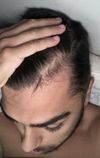
community Should I Switch to Oral Minoxidil While Continuing Dutasteride? Need Advice on Next Steps After Accelerated Shedding
The user is experiencing increased hair shedding and is considering switching from a topical solution containing minoxidil, finasteride, and tretinoin to oral minoxidil while continuing oral dutasteride. They are seeking advice on whether to make this switch or wait for the shedding to stabilize, and are concerned about potential side effects of oral minoxidil.